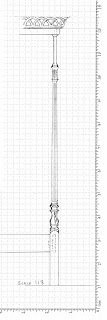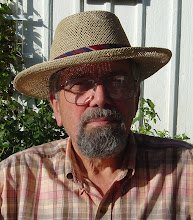
 You
can’t afford to take any chances with expensive wood, especially if the supply
is limited. I took a short piece of
pine, made it up in the same way as the posts just described and put it on the
lathe to turn a trial of the urn that adorns the upper end of the leg
section. This way you see whether the
theoretical design does in fact please the eye.
If so, then from it you take exact dimensions in order to copy the form
four times. If you are lucky enough to own a duplicating
lathe, then the trial piece may be mounted as template which will give you four
exact copies mechanically.
You
can’t afford to take any chances with expensive wood, especially if the supply
is limited. I took a short piece of
pine, made it up in the same way as the posts just described and put it on the
lathe to turn a trial of the urn that adorns the upper end of the leg
section. This way you see whether the
theoretical design does in fact please the eye.
If so, then from it you take exact dimensions in order to copy the form
four times. If you are lucky enough to own a duplicating
lathe, then the trial piece may be mounted as template which will give you four
exact copies mechanically.
 Next job is
to make a careful drawing for the carving on the urn and transfer this design
to the workpiece. I intended to carve four acanthus leaves around the urn. The transference can be done with carbon
paper, but I prefer to make small cardboard templates and trace around
them. The first templates I made were
too skinny – I hadn’t allowed enough for the varying circumference of the urn. Before
starting to carve I made a measured drawing of the trial urn, which serve as
the standard for four posts. Some carving on the trial piece is a
good idea to test the concept, but there’s no need to carve the entire urn. I went about halfway around. This is helpful
too as you learn and note which gouges will do best at the different parts of
the carving. After carving the same motif for a while you get in the swing of
it and will automatically reach for the right tool, but at first this is
difficult to remember, so when chopping in the trial carving I labelled a copy
of my acanthus drawing at every different curve with the identity of each tool
used.
Next job is
to make a careful drawing for the carving on the urn and transfer this design
to the workpiece. I intended to carve four acanthus leaves around the urn. The transference can be done with carbon
paper, but I prefer to make small cardboard templates and trace around
them. The first templates I made were
too skinny – I hadn’t allowed enough for the varying circumference of the urn. Before
starting to carve I made a measured drawing of the trial urn, which serve as
the standard for four posts. Some carving on the trial piece is a
good idea to test the concept, but there’s no need to carve the entire urn. I went about halfway around. This is helpful
too as you learn and note which gouges will do best at the different parts of
the carving. After carving the same motif for a while you get in the swing of
it and will automatically reach for the right tool, but at first this is
difficult to remember, so when chopping in the trial carving I labelled a copy
of my acanthus drawing at every different curve with the identity of each tool
used.
A final note. I am taking a large number of reference photos during this ongoing project. I am posting up the most relevant with this blog, and a very few of the most interesting ones on my Flickr site. For those interested in yet deeper detail I have all my pictures in a folder 'on the cloud' at my "Dropbox" site. Upon request I will be happy to send you a link to my Dropbox folder, and here below is a link to the 'Georgian Bed' set on Flickr: http://www.flickr.com/photos/a_henwood/sets/72157635480669119/














